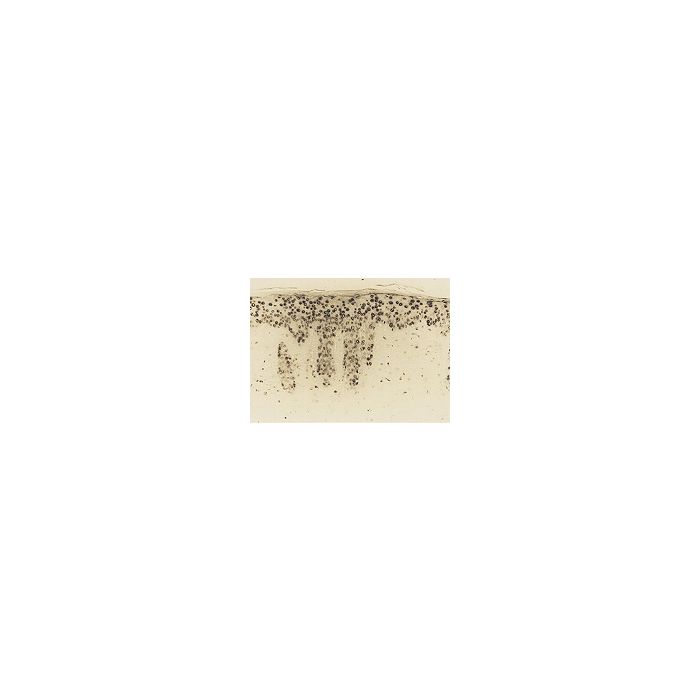Cookie Policy: This site uses cookies to improve your experience. You can find out more about our use of cookies in our Privacy Policy. By continuing to browse this site you agree to our use of cookies.
JaICA
anti-8-Hydroxy-2'-deoxyguanosine [8-OHdG], mAb (N45.1)

| Product Details | |
|---|---|
| Product Type | Monoclonal Antibody |
| Properties | |
| Clone | N45.1 |
| Isotype | Mouse IgG1κ |
| Source/Host | Ascites |
| Immunogen/Antigen | 8-Hydroxy-2’-deoxyguanosine (8OHdG) conjugated keyhole limpet hemocyanin. |
| Application |
Immunohistochemistry: Recommended concentration is 5-10μg/mL |
| Crossreactivity | All |
| Specificity |
Recognizes 8-OHdG. Does not cross-react with 19 analogues of 8-OHdG (guanosine (G), 7-methylG, 6-SHG, 8-bromoG, dA, dC, dT, dI, dU, dG, O6-methyldG, 8-OHdA, guanine (Gua), O6-methylGua, 8-OHGua, uric acid, urea, creatine, creatinine). Minimal cross-reactivity with 8-sulfhydrylG and 8-OHG (less than 1%). |
| Purity Detail | Ammonium sulfate purified. |
| Formulation | Lyophilized. Contains 10mM PBS, pH7.4 containing 1.0% BSA. |
| Reconstitution | Reconstitute with 200μL of distilled water. |
| Isotype Negative Control | |
| Other Product Data |
Click here for Original Manufacturer Product Datasheet |
| Declaration | Manufactured by JaICA. |
| Shipping and Handling | |
| Shipping | BLUE ICE |
| Short Term Storage | +4°C |
| Long Term Storage | -20°C |
| Handling Advice | Avoid freeze/thaw cycles. |
| Use/Stability |
Stable for at least 3 years after receipt when stored at -20°C. After reconstitution, prepare aliquots and store at -20°C. |
| Documents | |
| Protocols |
 Download PDF Download PDF |
| Product Specification Sheet | |
| Datasheet |
 Download PDF Download PDF |
8-hydroxy-2'-deoxyguanosine (8-OHdG) is a modified base that occurs in DNA due to attack by hydroxyl radicals (incl. singlet oxygen and direct photodynamic action) that are formed as byproducts and intermediates of aerobic metabolism and during oxidative stress. There is increasing evidence to support the involvement of free radical reactions in the damage of biomolecules that eventually lead to several diseases in humans, such as atherosclerosis, cerebral and heart ischemia-reperfusion injury, cancer, rheumatoid arthritis, inflammation, diabetes, aging, and neurodegenerative conditions, such as Alzheimer’s disease. 8-OHdG is popular as a sensitive, stable and integral marker of oxidative damage in cellular DNA and can be detected in tissue, serum, urine and other biomaterials.
- Quantitative immunohistochemical determination of 8-hydroxy-2'deoxyguanosine by a monoclonal antibody N45.1: Its application to ferric nitrilotriacetate-induced renal carcinogenesis model: S. Toyokuni, et al.; Lab. Invest. 76, 365 (1997) [Specifity of the antibody clone N45.1]
- 8-Hydroxy-2'deoxyguanosine is increased in epidermal cells of hairless mice after chronic ultraviolet B exposure: Y. Hattori, et al.; J. Invest. Dermatol. 107, 733 (1996) [Immunohistochemistry of UV-B irradiated mouse skin]
- Induction and nuclear translocation of thioredoxin by oxidative damage in the mouse kidney: independence of tubular necrosis and sulfhydryl depletion: T. Tanaka, et al.; Lab. Invest. 77, 145 (1997) [Immunohistochemistry of ferric nitrotriacetate-treated mouse kidney]
- Hyperglycemia causes oxidative stress in pancreatic -cells of GK rats, a model of type 2 diabetes: Y. Ihara, et al.; Diabetes 48, 927 (1999) [Immunohistochemistry of pancreatic islets from GK rat, a diabetes model]
- DNA oxidation injury in bone early after steroid administration is involved in the pathogenesis of steroid-induced osteonecrosis: T. Ichiseki, et al.; Rheumatology 44, 456 (2005) [Immunohistochemistry of rabbit tissue]
- Protective effect of persimmon (Diospyros kaki) peel proanthocyanidin against oxidative damage under H2O2 -induced cellular senescence: Y.A. Lee, et al.; Biol. Pharm. Bull. 31, 1265 (2008) [Application to human cultured cells]
- Disruption of mitochondrial complex III in cap mesenchyme but not in ureteric progenitors results in defective nephrogenesis associated with amino acid deficiency: N. Guan, et al.; Kidney Int. ahead of print (2022)






![anti-8-Hydroxy-2'-deoxyguanosine [8-OHdG], mAb (N45.1)](https://adipogen.com/media/catalog/product/cache/60eb5af712bc93baae8d55513bd31b01/j/a/jai-mog-ihc-8ohdg_stain_3.jpg)

